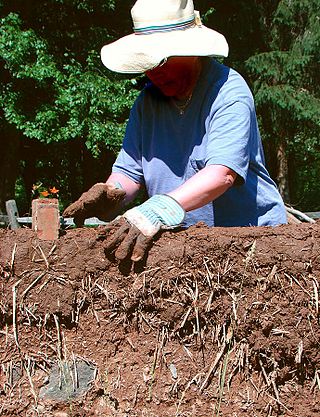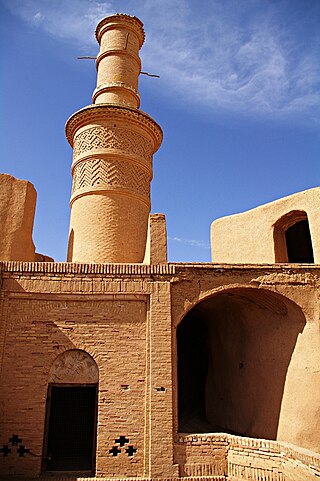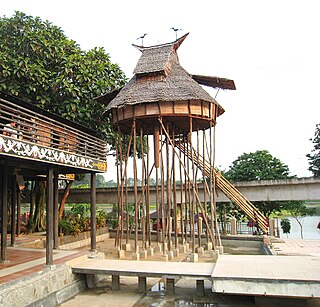
Adobe is a building material made from earth and organic materials. Adobe is Spanish for mudbrick. In some English-speaking regions of Spanish heritage, such as the Southwestern United States, the term is used to refer to any kind of earthen construction, or various architectural styles like Pueblo Revival or Territorial Revival. Most adobe buildings are similar in appearance to cob and rammed earth buildings. Adobe is among the earliest building materials, and is used throughout the world.

A brick is a type of construction material used to build walls, pavements and other elements in masonry construction. Properly, the term brick denotes a unit primarily composed of clay, but is now also used informally to denote units made of other materials or other chemically cured construction blocks. Bricks can be joined using mortar, adhesives or by interlocking. Bricks are usually produced at brickworks in numerous classes, types, materials, and sizes which vary with region, and are produced in bulk quantities.

A levee, dike, dyke, embankment, floodbank, or stop bank is a structure used to keep the course of rivers from changing and to protect against flooding of the area adjoining the river or coast. It is usually earthen and often runs parallel to the course of a river in its floodplain or along low-lying coastlines.

An earth shelter, also called an earth house, earth bermed house, or underground house, is a structure with earth (soil) against the walls, on the roof, or that is entirely buried underground.

A mastaba, also mastabah or mastabat) is a type of ancient Egyptian tomb in the form of a flat-roofed, rectangular structure with inward sloping sides, constructed out of mudbricks or limestone. These edifices marked the burial sites of many eminent Egyptians during Egypt's Early Dynastic Period and Old Kingdom. Non-royal use of mastabas continued for over a thousand years.

Mudbrick or mud-brick, also known as unfired brick, is an air-dried brick, made of a mixture of mud mixed with a binding material such as rice husks or straw. Mudbricks are known from 9000 BCE.

Cob, cobb, or clom is a natural building material made from subsoil, water, fibrous organic material, and sometimes lime. The contents of subsoil vary, and if it does not contain the right mixture, it can be modified with sand or clay. Cob is fireproof, termite proof, resistant to seismic activity, and uses low-cost materials, although it is very labour intensive. It can be used to create artistic and sculptural forms, and its use has been revived in recent years by the natural building and sustainability movements.

Rammed earth is a technique for constructing foundations, floors, and walls using compacted natural raw materials such as earth, chalk, lime, or gravel. It is an ancient method that has been revived recently as a sustainable building method.

Hassan Fathy was a noted Egyptian architect who pioneered appropriate technology for building in Egypt, especially by working to reestablish the use of adobe and traditional mud construction as opposed to western building designs, material configurations, and lay-outs. Fathy was recognized with the Aga Khan Chairman's Award for Architecture in 1980.

Sudano-Sahelian architecture refers to a range of similar indigenous architectural styles common to the African peoples of the Sahel and Sudanian grassland (geographical) regions of West Africa, south of the Sahara, but north of the fertile forest regions of the coast.

Soil fertility refers to the ability of soil to sustain agricultural plant growth, i.e. to provide plant habitat and result in sustained and consistent yields of high quality. It also refers to the soil's ability to supply plant/crop nutrients in the right quantities and qualities over a sustained period of time. A fertile soil has the following properties:

Natural building or ecological building is a discipline within the more comprehensive scope of green building, sustainable architecture as well as sustainable and ecological design that promotes the construction of buildings using sustainable processes and locally available natural materials.

An earth structure is a building or other structure made largely from soil. Since soil is a widely available material, it has been used in construction since prehistory. It may be combined with other materials, compressed and/or baked to add strength.

A compressed earth block (CEB), also known as a pressed earth block or a compressed soil block, is a building material made primarily from an appropriate mix of fairly dry inorganic subsoil, non-expansive clay, sand, and aggregate. Forming compressed earth blocks requires dampening, mechanically pressing at high pressure, and then drying the resulting material. If the blocks are stabilized with a chemical binder such as Portland cement they are called compressed stabilized earth block (CSEB) or stabilized earth block (SEB). Typically, around 3,000 psi (21 MPa) of pressure is applied in compression, and the original material volume is reduced by about half.

An embankment dam is a large artificial dam. It is typically created by the placement and compaction of a complex semi-plastic mound of various compositions of soil or rock. It has a semi-pervious waterproof natural covering for its surface and a dense, impervious core. This makes the dam impervious to surface or seepage erosion. Such a dam is composed of fragmented independent material particles. The friction and interaction of particles binds the particles together into a stable mass rather than by the use of a cementing substance.
Ceramic houses are buildings made of an earth mixture which is high in clay, and fired to become ceramic. The process of building and firing such houses was developed by Iranian architect Nader Khalili in the late 1970s; he named it Geltaftan. "Gel" means "clay" and "taftan" means "firing, baking, and weaving clay" in Persian language. Khalili's research into creating ceramic houses was strongly based on the idea that permanent, water-resistant, and earthquake-resistant houses could be built with the implementation of the four elements: earth and water to build the forms, and fire and air to finish them. His impassioned work led to a few small scale projects in Iran, including the Javadabad Elementary School, and the Ghaled Mofid restoration project. Aside from Khalili's own documented work, there seems to be little widespread research on ceramic houses.

Stilts are poles, posts or pillars used to allow a structure or building to stand at a distance above the ground or water. In flood plains, and on beaches or unstable ground, buildings are often constructed on stilts to protect them from damage by water, waves or shifting soil or sand. As these issues were commonly faced by many societies around the world, stilts have become synonymous with various places and cultures, particularly in South East Asia and Venice.

Banasura Hill Resort is a nature resort in Wayanad District of North Kerala, India; located 37 kilometres (23 mi) away from Kalpetta, the district headquarters. It stands at an altitude of 3,200 feet (980 m) above sea level on a 35 acres (14 ha) plot amidst the mountains of the Western Ghats declared as one of the traditionally preserved sites in the world by UNESCO.

Musgum mud huts or Musgum dwelling units are traditional domestic structures built of mud by the ethnic Musgum people in the Maga sub-division, Mayo-Danay division, Far North Province in Cameroon. Referred to in Munjuk as Tolek, the dwellings are built in a variety of shapes, such as tall domed or conical dwellings or huts, some with a reverse-V shape, and others with geometric designs.

Choga is a term for traditional Korean houses (hanok) with thatched roofing. The main building materials used to build these houses are straw, wood and soil.


















